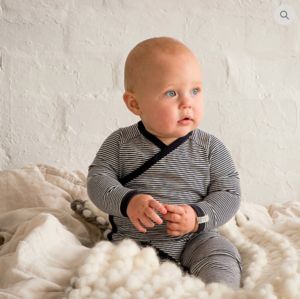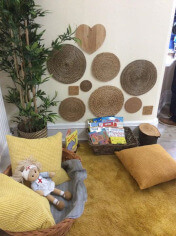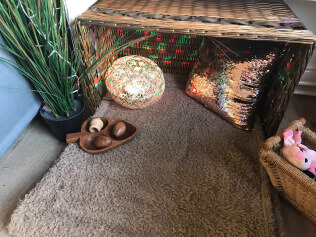How to bring Hygge into Early Years?
Release Date: December 10, 2019
Last Updated: October 7, 2021
Your nursery or education environment should be a place of HYGGE.
At The Curiosity Approach, we first introduced the word 'Hygge', in our latest book The A-Z of The Curiosity Approach 2017, but what does it mean and why should we pay attention to the physical environment we provide for children?
Hygge (pronounced hue-guh not hoo-gah) is a Danish word used when acknowledging a feeling or moment, ordinary or extraordinary as cosy, charming or special.
Hygge is a feeling you cannot translate.
It’s about a space that promotes emotional well-being, togetherness and friendship. It’s a place children, can feel comfortable to snuggle down or explore with confidence.
Far removed from an institutionalized sterile setting, hygge offers children within your setting a sense of security and well-being. An extension of their home and not a watered-down version of school.
Maria Montessori said “adults admire their environment; they can remember it and think about it – but a child absorbs it. The things he sees are not just remembered; they form part of his soul. He incarnates in himself all in the world about him that his eyes see and his ears hear”.
As we are all aware in Early Years levels of well-being are fundamental to children’s development and progress. Thoughtful caring practitioners, ensure secure relationships are formed, building connections and helping children to settle into nursery life. Practitioners must not only work hard to develop these attachments, remembering the physical environment is fundamental to children’s well-being too.
In the 1800s, Friedrich Froebel stressed the importance of environmental design in terms of a garden: natural, organic, and ever-changing. He maintained that when care is applied to a child’s surroundings, behaviour can be guided and inspired. The simplest of spaces can become a haven of play and learning
“When children feel comfortable in their physical surroundings, they will venture to explore materials or events around them.” –Anita Rui Olds
What is well-being?
Well-being is a particular state or feeling that can be recognized by satisfaction, enjoyment & pleasure. The person is relaxed and expresses inner rest, feels the energy flow and radiates vitality, is open to the surroundings, accessible and flexible.
Professor Ferre Laevers:
Enjoyment – The children look happy, smile or laugh easily, engage spontaneously in chatting or even singing
Relaxed and inner peace children have a relaxed and open expression, not feeling wary or uncomfortable in any way.
Vitality children’s body language is strong, their chest and head is high and not slouched. Their expressions are radiant and bright.
Self-confidence children are confident in their own self and abilities.
Why are we doing what we are doing? Many have questioned, who is it for?
Only today, my attention was drawn to an amazing quote which totally encapsulates our thoughts and feelings at The Curiosity Approach:

How can we bring Hygge to our provision?
Within a Hygge setting, there will be a calm relaxed feel to the play space with areas for children to retreat and get comfortable or cosy.
- View the environment through the eyes of the child.
- Invite children to create dens or cosy corners, with the use of drapes, voiles and blankets.
- Set up thoughtful nooks and well-appointed retreats, position them away from the main traffic within your setting.
- Provide children with a place to retreat away from the hustle and bustle of the main movement of the setting, allowing children privacy to talk, chat and interact.
- Provide plump cushions and blankets which enable children to get cosy when reading books or engaging in a provocation.
- Well appointed twinkly lights to add a sense of magic and wonder
- Lighting is soft and muted.
- Artificial light is kept to a minimum, use of table or standard lamps
- Reduction of noise levels, through soft furnishings.
- A range of textures.
- Provide opportunities to crawl inside a baby nest or enclosed area where they feel secure.
- Provide seating where children can curl up with a nice book.


Hygge within your early years provision will help impact learning and ensure we value the children within! Cherish the little miracles we have the privilege of educating and create environments that show them how special and unique they really are.
At The Curiosity Approach education is not drip fed through the tops of children’s heads, it comes from the heart and soul and only with true connections of heart and mind can we truly educate the whole child.
Are you curious to see how well you are implementing The Curiosity Approach?
Take the quiz here
Copyright ©The Curiosity Approach 2021 All Rights Reserved
All files and information and images contained in this Website or Blog are copyright-protected by The Curiosity Approach Ltd, and may not be duplicated, copied, modified or adapted, in any way without our written permission. Our Website or Blog may contain our service marks or trademarks as well as those of our affiliates or other companies, in the form of words, images, graphics, and logos. Your use of our Website, Blog or Services does not constitute any right or license for you to use our service marks or trademarks, without the prior written permission of The Curiosity Approach Ltd. Our Content, as found within our Website, Blog and Services, is protected under UK and foreign copyrights. The copying, redistribution, use or publication by you of any such Content, is strictly prohibited. Your use of our Website and Services does not grant you any ownership rights to our content


